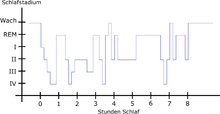Non-REM sleep

Non-REM sleep (also: orthodox sleep or NREM sleep ) is one of the two forms of sleep in sleep research and sleep medicine, alongside REM sleep (REM, English Rapid Eye Movement) .
Classification and characteristics
In the further classification of NREM sleep, a distinction is made between the sleep stages N1, N2 and N3. This nomenclature goes back to a 2007 publication by the American Academy of Sleep Medicine . The sleep stage N1 stands for the transition between waking and sleeping, N2 stands for stable sleep and N3 stands for deep sleep. The NREM sleep as a whole is also known as sleep stage N , respectively.
The individual sleep stages have characteristic features in the electrical activity of the brain and can be measured and delimited. The assignment of time periods of sleep to the sleep stages occurs during the evaluation of the examination carried out by means of polysomnography and is used to evaluate sleep in the context of the diagnosis of sleep disorders . It is shown in the sleep profile (hypnogram). In this context, stage R is used for REM sleep and stage W for wakefulness.
The sleeper's body temperature and blood pressure drop during NREM sleep, and he hardly dreams .
The share of the individual sleep stages in the duration of sleep is not a fixed variable, but changes with age depending on gender. In healthy people there are 4 to 7 sleep cycles of around 70–110 minutes each night , during which the NREM stages N1, N2 and N3 and again N2 followed by REM sleep are passed through. In the following cycles, the proportion of deep sleep decreases and the REM proportion increases. In a person around 30 years old, the proportion of the 3 NREM stages in the total duration of night sleep is above 70%.
Sleep stage N1
Transition between waking and sleeping:
- The electroencephalogram (EEG) shows theta activity , a sign of sleepiness in healthy adults.
- The electromyogram (EMG) shows a decrease in muscle tone compared to the waking state.
- The electrooculogram (EOG) shows slow, sometimes rolling eye movements.
The proportion of the total duration is around 5% in middle age (approx. 30 years).
Sleep stage N2
Stable sleep:
- The EEG shows theta activity, K complexes, and sleep spindles .
- The EMG shows a decrease in muscle tone compared to stage N1.
- The EOG shows no eye movements.
The proportion of the total duration in middle age (approx. 30 years) is around 45–55%.
Sleep stage N3
Deep sleep:
- The EEG shows delta activity .
- The EMG shows a decrease in muscle tone compared to stage N2.
- The EOG shows no eye movements.
The proportion of the total duration is around 15-25% in middle age (approx. 30 years).
Sleep stages according to Rechtsschaffen and Kales
An earlier nomenclature used for many years goes back to a publication by Allan Rechtschaffen and Anthony Kales in 1968. There, NREM sleep was divided into 4 stages, 2 light sleep stages and 2 deep sleep stages. The note “according to R + K” in the relevant literature refers to this classification. The two deep sleep stages are now combined as stage N3.
literature
- American Academy of Sleep Medicine (Ed.): The AASM Manual for Scoring Sleep and Associated Events. Rules, technology and technical specifications . 1st edition. Steinkopff-Verlag, Heidelberg 2008, ISBN 978-3-7985-1851-3 .
Individual evidence
- ↑ C. Iber, S. Ancoli-Israel, AL Chesson, SF Quan: The AASM Manual for the Scoring of Sleep and Associated Events: Rules, Terminology, and Technical Specifications. Ill, American Academy of Sleep Medicine, Westchester 2007.
- ↑ a b c d H.-G. Weeß, R. Landwehr: Phenomenology, function and physiology of sleep. In: Psychotherapy in dialogue. 10 (2), 2009, pp. 101-106.
- ↑ S3 guideline - non-restful sleep / sleep disorders. German Society for Sleep Research and Sleep Medicine (DGSM), Springer-Verlag, 2009, p. 14 ff.
- ^ Allan Rechtsschaffen, Anthony Kales: A manual of standardized terminology, techniques and scoring system for sleep stages of human subjects . No. 204 . US Dept. of Health, Education, and Welfare, Public Health Services-National Institutes of Health, National Institute of Neurological Diseases and Blindness , Neurological Information Network, 1968.


